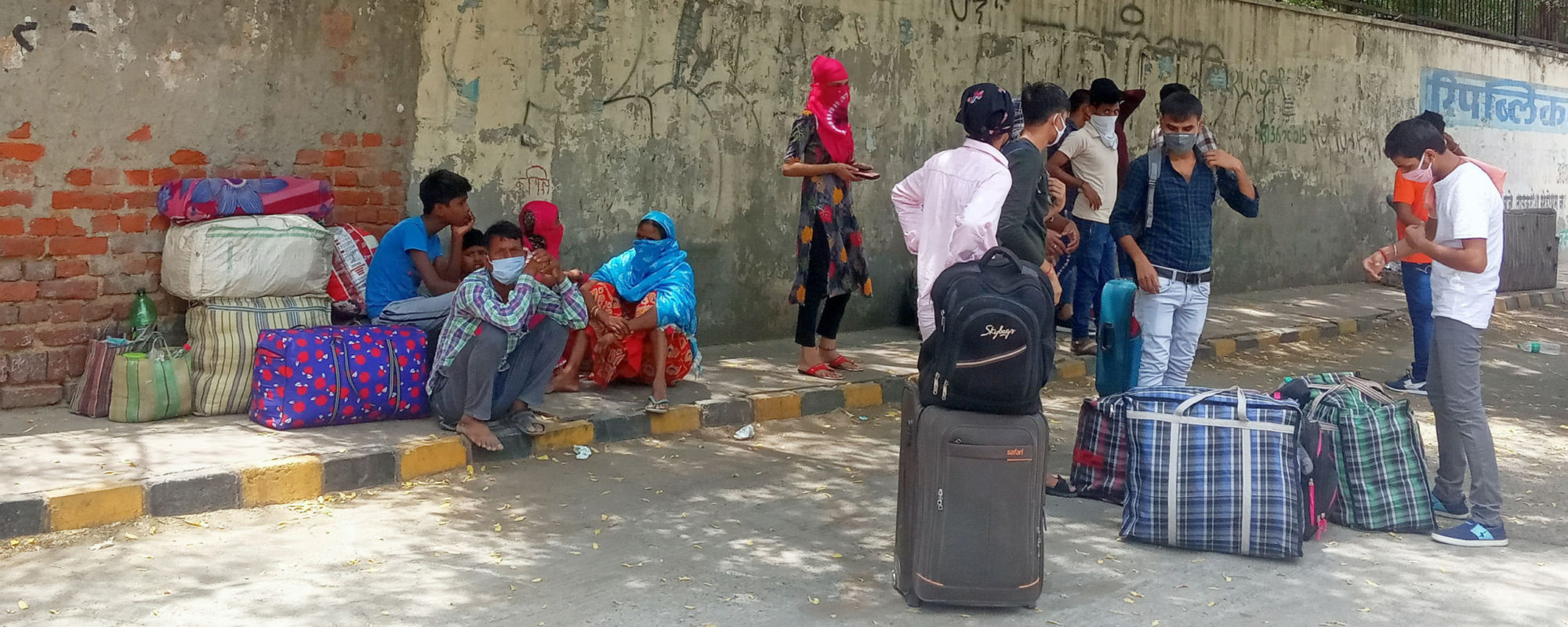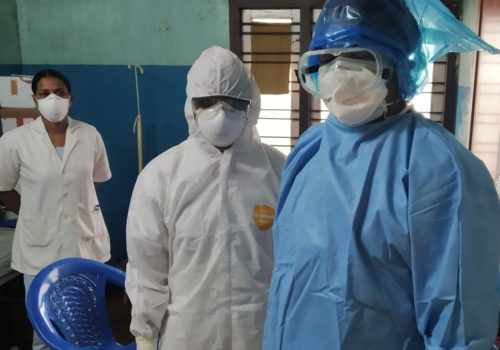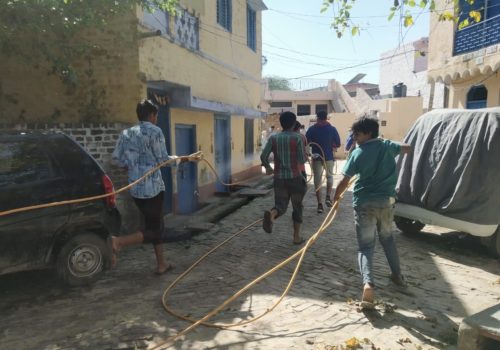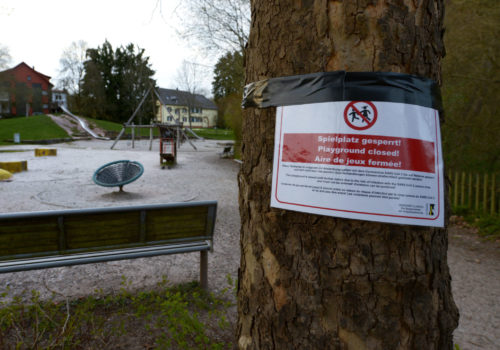The migrant workers begin arriving in the early hours of the morning, tired but determined, hoping to be first in line. They crouch and wait for the sun to rise, clutching knotted rags that hold their belongings: clothes, shoes, a bed cover, a broom, ornaments they’ve collected. They’ve spent the night on makeshift beds—a dirt path on the side of the road, under a shady tree, near abandoned railway tracks—and walked 20 miles to get here. The soles of their feet are shredded from walking barefoot.
In early May, the Delhi authorities converted a large school playground across the street from my apartment into a temporary bus depot. Every day, I witness the same spectacle unfold from my bedroom window; an invisible wall dividing the haves from the have-nots. Dozens of long, slender, lime green buses arrive and park by the roadside, waiting to shuttle the migrant workers across state borders and back to their hometowns. At last they can return home, no longer subject to charity or other forms of humiliation.
Before the government imposed an abrupt lockdown on the nation in March on the cusp of the coronavirus crisis, 400 million such workers, many belonging to India’s lower castes—the Dalits and tribal peoples—had been invisible to most Indians as they silently carried out their daily tasks of rag picking, construction and domestic work. Suddenly, gathered together in large numbers, they were unavoidable.
Many Indians sheltering at home are finally confronted by those on the margins of their society, inundated by daily images and videos that capture the agony of the migrant workers’ long journeys home. They include a scene on a railway platform in Muzaffarpur in the northeastern state of Bihar: a 35-year-old woman named Arbina Khatoom found lying still, clad in a pink sari, while her half-naked toddler tugged at a sheet partially covering her face. He was trying to wake up his mother, believed to have died of hunger and dehydration, surrounded by two bags stuffed with her belongings and another child, who watched with a water bottle in hand.
Another woman, pregnant while she walked 99 miles from Maharashtra to Madhya Pradesh, delivered a baby on the road after experiencing labor pain. She rested for two hours before she and her husband resumed their walk home. The local administration finally arranged a bus for the couple at the border of their town, along with check-ups for both mother and baby. Even for those who make it back, homecoming is often bitter: thrust into family feuds and land disputes, they can feel like burdens or liabilities. At the worst of times, they die from starvation, accidents or suicide.
As the pandemic spread across the globe, economic inequality has intensified some of most devastating effects on the poorest people. But the poor aren’t the only migrants in this transient country, and the treatment of the worst-off has revealed who is allowed dignity in a deeply entrenched and inescapable caste system, focused on one of the most basic rights: going home.
* * *
I, too, am a migrant in India, my birth country. Three months ago, before the virus infiltrated the country’s collective conscience, I returned from the United States to undertake this fellowship. To say I arrived at the weirdest possible time would be an understatement. The last time I lived here was just under 20 years ago, and now, India felt both intimate and alien. How does one belong to a place after occupying gray territories, in-betweens, for so long?
I wasn’t considered Indian anymore, just one of the 17.5 million members of the diaspora spread around the world. That community is filled with abbreviations—NRIs (Non-Resident Indians), PIOs (Persons of Indian Origin), OCIs (Overseas Citizens of India)—people who have left the homeland since the Partition, the great British colonial experiment of 1947, in search of a better future. For my own family, migrating west meant escaping a typical upper-middle-class life. Despite its many benefits in the social hierarchy, it’s often more defined by limits than freedoms.
My parents recognized those freedoms whenever we traveled abroad—international passports that didn’t require months-long waits for visa approvals; better education that led to greater opportunities; the ability to earn stable hard currency. So we moved to Australia when I was nine.
During my childhood in Sydney, my priority was assimilation. But back in India, we had been automatically elevated into one of the abbreviated categories. Years later, the Indian government began hosting a biennial Pravasi Bharatiya Diwas (“Non-Resident Indian Day”), to reconnect and engage with all people of Indian origin across borders. When I was at university in 2014, Prime Minister Narendra Modi visited Sydney, still early in his first term, attending a stadium event where the receptive audience resembled crowds at a rock concert. He touted the ideals of a “new” India—full of potential and energy, free of corruption and bureaucracy, one that needed the diaspora’s contributions. Offering an OCI scheme, he welcomed us back to the homeland we left many years ago with open arms, declaring: “Within all of us, there is only one dream: Bharatiyata,” or an Indian way of life.
India is a country where even those who never leave are in transit. When the lockdown put the nation on pause, internal migrants lost their jobs and faced starvation. With public transport suspended, they also had nowhere to go.
When I moved to New York to work in journalism several years ago, I recognized the same energy and enthusiasm for Modi among some Indian-Americans, particularly from my parents’ generation, who truly believed he could make India great again. It was a year before Donald Trump was elected president, when Modi supporters recognized in him what they saw in the Indian leader—a firm commitment to economic growth and a hardline policy against “radical Islamic terrorism.” (As it happens, Trump was the first US presidential candidate to attend a Hindu event.) The wealthiest ethnic group in the United States, Indian-Americans were weaponized for the myth of the model minority: that our demographic was successful because of hard work and good behavior, not handouts.
As I prepared for my move, I was excited to ignite my own Bharatiyata. It would be my homecoming: Finally I could bridge the gaps in my own understanding of the land and its people. But many Indians I knew, in the diaspora and inside India, seemed perplexed by my decision to move back. After all, the rejection of a place lies at the core of migration: those who leave, whether by choice or because of circumstance, are forced to say their goodbyes. To return is to confront what they left behind in the first place. It’s to ask: Was it a good decision to leave, after all?
I happened to land in New Delhi in February on the same day as Trump, here for a whirlwind two-day visit. On television, the day was marked by broadcasting the dazzling spectacle of a 110,000-person rally for Modi and Trump inside a cricket stadium, even as waves of rioting, violence between Hindus and Muslims and the destruction of homes began to boil to the surface in the city’s north east area. Trump loved India nevertheless: “From this day onward,” he said, “India will always hold a special place in our hearts.”
But with a public health crisis looming in America immediately after Trump’s return, that special place began to shrink. With a single tweet, he upended the lives of thousands of Indians who hoped to build a life in his country by announcing a crackdown on immigration. Later, he clarified that any new arrivals would be suspended for 60 days, along with a temporary halt in the issuing of green cards. Thousands of highly skilled workers from India saw a threat to programs like H-1B visas for highly skilled workers (of which Indians hold nearly 76 percent), and feared a general uprooting of foreign workers due to the rising unemployment rate. It wasn’t just Indians in the who felt that, of course. Many of my fellow Australians in New York, who enjoyed fewer restrictions as migrants, began to express uncertainty over their futures on Facebook, too.
When my personal quest was also thrown into a global crisis with a nationwide lockdown in full-force, I spent months in the comfort of my apartment, observing India and her people at bay. Maybe it takes a pandemic to strip a nation of her myths, I thought, and expose her truths: Who can afford to stay home and enjoy luxuries? Who can call a doctor when sick, and later leave a hospital ward fully recovered? Who can lead a nation through a public health crisis? Who can keep a job and still survive in a worn-out economy? Who can choose to go back home? The answers will help define what comes next.
* * *
My homecoming also coincided with Vande Bharat—the government’s mission to repatriate the many Indians stranded in over 40 countries since the imposition of coronavirus restrictions. Distressed workers who lost jobs overseas, stranded tourists, students on visa restrictions and those in need of medical care, have been flown back on commercial flights from around the world. Their return is a bittersweet blessing in this abnormal time—after bearing the cost of flights and quarantine facilities, they recover from their often long journeys in self-isolation in hotel rooms or at home, trying to plan for their futures.
All of us returnees have come back to a country where even those who never leave are in transit. India is overwhelmingly a country of migrants, but members of the largest of these groups don’t carry blue passports stamped with visas in search of new horizons; they are workers who migrated internally, leaving their villages to cross thousands of miles in search of work in the cities, their toil compensated in daily wages. The lockdown put the nation on pause; they, too, faced layoffs, and without any work, would almost certainly starve. With public transport suspended, they also had nowhere to go. Some retreated to shelter homes organized by their employers or the government, others were forced to live on the streets.
Some 96 percent of the 11,159 workers surveyed in a report by the Stranded Workers Action Network in April revealed that they hadn’t received any financial help from the government, while 78 percent was surviving on a total of less than 300 rupees ($3.97 USD). The workers are also at greater risk of contracting the coronavirus than the rest of the population: In the northern state of Uttar Pradesh, the last week of May saw a quantum jump in Covid-19 symptomatic cases due to the return of migrants, with more than a thousand people testing positive on a single day.
But before they can return many migrants must join long lines, some of them outside my window, waiting for buses and trains to take them home. When I spoke to a group of such workers, they told me they had waited for 10 days at another bus shelter before being told they could finally board a bus that day to take them home. Hours later, without any explanation, that bus was canceled. “Where are we supposed to go if not our own homes?” one told me, disgruntled and utterly helpless.
Although they are not part of the vaunted diaspora, they contribute over $170 billion to the nation’s economy—6 percent of India’s GDP—and the dream of a prosperous nation Modi so recently peddled to Indians abroad. So when it was time to send everyone home, why were they so easily forgotten by the government, when Indians abroad were not? Some argue the answer has driven home the truth that migrant workers have always been invisible and their lives expendable to India’s policymakers.
Not having ventured far beyond the gates of my neighborhood, I feel it absurd to compare my own migration to those of the workers at the bus depot. For so long, I believed India was my first home that would embrace me with open arms. And it has—the hot, sultry air and everyday chaos fills my senses even as I merely perch over my balcony. But the pandemic has forced a reckoning over the sense that homecoming is a privilege afforded only to those whose lives the government deems worthy.
Photo: Waiting outside a New Delhi railway station, May 2020 (Roy Dutta, https://commons.wikimedia.org/wiki/File:Stranded_migrant_workers_during_fourth_phase_of_the_lockdown_IMG_20200523_125500.jpg)




